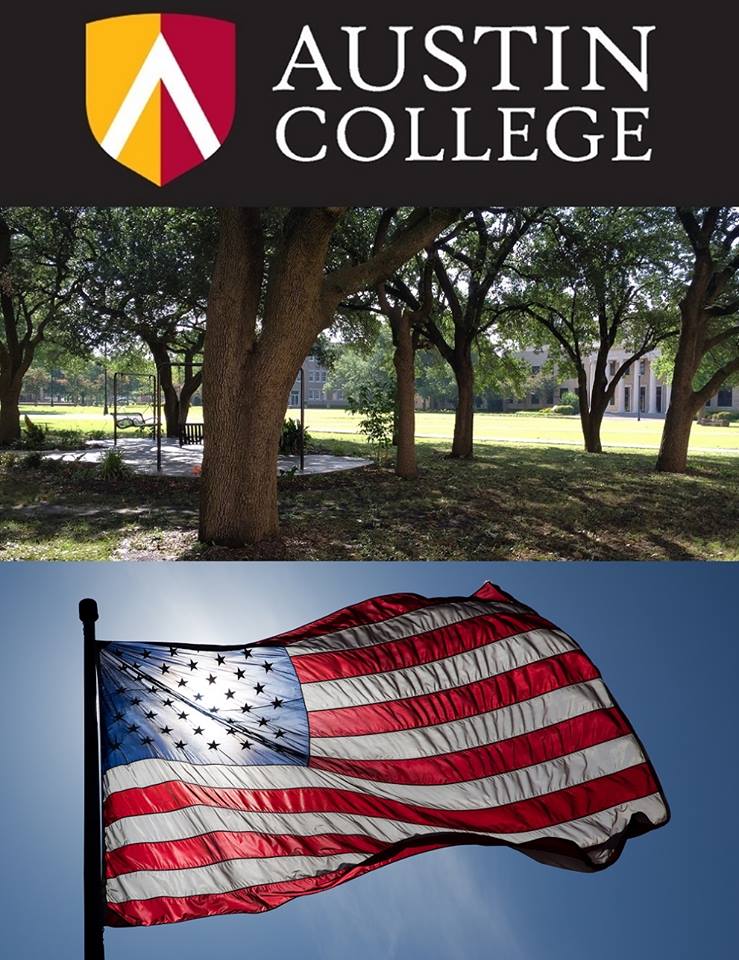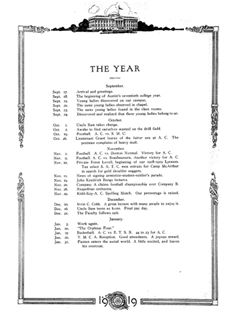
Probably gonna see a lot of photos of Ol’ Glory online today. Hey, me too. It’s important to remember.
The fall of 1918 was a time of immense change around the country.
At my alma mater as well. The first class of women enrolled that semester. They were met with reactions that ranged from curiosity to outright hostility. Of course, being Austin College women, they forged on, created their own institutional space, and dared the men to stand athwart history yelling Stop! AC men in their wisdom decided to take a pass.
America’s entry into war meant a smaller student body. Roos had enlisted with Uncle Sam across the board, and could be found at military camps around the state and nation. Ewell D. Walker was training at Camp MacArthur in San Antonio that fall; without the conflict, he would have been participating in his final season of AC football. But do not shed any tears for Walker. He returned to graduate, enjoyed a career in education in Dallas, and watched his son Doak Walker win nearly every football award imaginable. Claude Webb Jr., who coached a Doak Walker Award recipient, can tell a great Walker tale. See the comments.
Many who remained participated in the Student Army Training Corps (SATC), a US military / university partnership to keep students on campus and prepare them for service if necessary. The semester became more physical and structured for all males, something resembling an intensive ROTC. As a military institution itself in the 1890s, it was probably not a difficult transition for AC. The nickname Kangaroo had in fact come from one of those military traditions. Roo footballers who participated in the war-shortened 1918 football season were all members of the SATC. There was a recent article in “The Athletic” about the SATC and the shortened 1918 season sent to me by Todd Treible. Thanks Todd. See the comments if you have a subscription.
Other Roos, however, were already in Europe. Many of these students had enlisted soon after the declaration of war in the spring of 1917 by the Congress, and had completed their training well before the fall of 1918. When the war came to an end on the 11th hour of the 11th day of the 11th month in 1918, most returned home to their families and friends.
The AC yearbook of 1918 noted the important dates of the 1918 fall semester. The women are there, pushing the school towards progress. The football is there too, represented by SATC men. So is Armistice Day:
“Nov. 11. News of signing armistice-student-soldier’
But not every Roo made it back for the parade. 12 AC students paid with their lives. They are memorialized by 12 Oaks which were planted after the War and sit between Dean & Baker Hall. The idea to plant the Oak trees was encouraged and promoted by President Clyce, whose tenure lasted from 1900 until 1931.
I’ve always known about the Oaks, but they’ve taken on a special meaning with my dives back into AC’s historical past. It’s almost like I’m there, hearing the joy of the news of 11/11/1918 and the sorrow of learning which Student would not be back. I even wrote a Memorial Day Roo Tale about one of those students represented by an Oak. His name was John Morgan Currie. You can read his story in the comments.
Currie lost his life within minutes of the launch of the St. Mihiel offensive, the first of a handful of major American advances that finally ended the most brutal conflict the world had yet seen. His paths crossed with George Patton & Douglas MacArthur, and accounts of his service by his fellow soldiers are positive. He was promoted multiple times during the war, eventually achieving First Lieutenant of the 42nd Rainbow Division. After his death, he was awarded the French “Croix de Guerre.” It is the highest designation a foreign military official can receive from Paris.
The offensive at St. Mihiel began at 5:00 a.m. on September 12, 1918. Back in Texas, it was still September 11th. Today. One hundred years ago.
From Lieutenant Hugh Thompson’s book “Trench Knives and Mustard Gas, with the 42nd Rainbow Division in France”:
“’No reprieve,’ I muttered. ‘No reprieve from the punishment of five o’clock.’ It was all a dream; a nightmarish dream, this business of five o’clock. Remember, it was nearly half a mile to the Bois de la Sonnard and the first line [of defense] we must rout out of the woods. Five o’clock. The crushing weight hung like a pall over the bluffing words of Jim, who griped about our lack of wire cutters and bombs; over Pierce’s sarcastic rejoinder that maybe Gen. Pershing would call off the war until Jim got fixed. Five o’clock. I tried to whip myself into a fury of hate, but hate simply would not come to relieve the gnawing fear. Four thirty-five…four thirty-eight; time was fleeting, fleeting toward the end. Would the suffocating burden never lift? ‘See you in Essey,’ barked Jim, above the swishing shells. Four fifty-seven…four fifty-eight. ‘Good luck, good luck,’ the voices rang…”
It’s impossible to write about a subject and not feel a personal connection. I’ll admit the same for Mr. Currie. I can never walk by the Oaks the same way again. Next time I’m on campus, I’ll probably stop in that area and reflect.
Conflict is always brutal. It’s also political and complicated. It can even be unjust and at times an outright mistake. But the brave service of women and men should be honored. It’s important to remember. Especially when they are Roos.

https://theathletic.com/468480/2018/08/14/influenza-war-1918-season-college-football-influence/
http://roonation.org/john-morgan-currie-class-of-1917/
